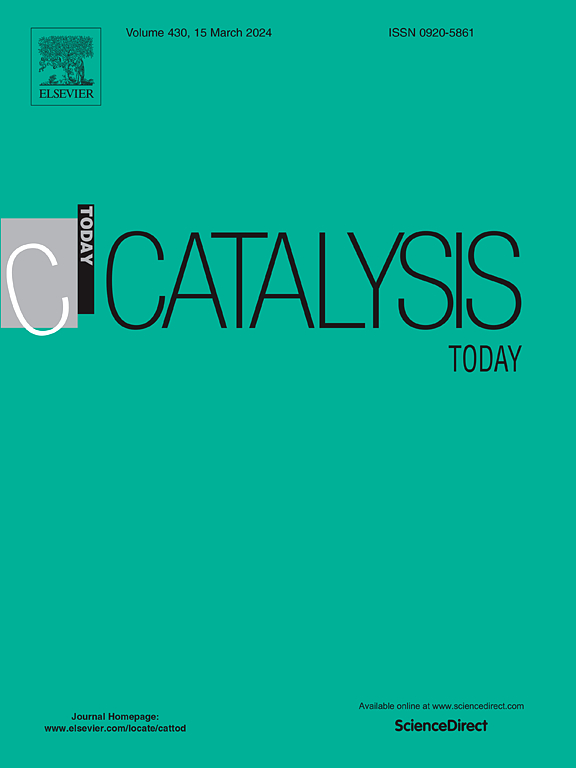Preparation of solid superacid catalyst Al2(SO4)3/ZrO2-TiO2 and its mechanism of borneol synthesis from pinene
IF 5.2
2区 化学
Q1 CHEMISTRY, APPLIED
引用次数: 0
Abstract
Natural borneol has enormous medicinal value (like clearing heat, detoxifying, relieving pain, and other effects) but has a low yield and high price. Compared with the natural extraction method to obtain borneol, a synthetic method has significant advantages such as high yield, environmental protection, and high economic benefits. In the synthesis method, the catalyst is the most key factor. In this study, two catalysts (SO42-/ZrO2-TiO2 and Al2(SO4)3/ZrO2-TiO2) with high catalytic performance and high positive selectivity were synthesized by impregnation method to synthesize borneol from α-pinene. The optimum synthesis conditions of SO42-/ZrO2-TiO2 were as follows: n(Zr): n(Ti) = 3: 1, sulfuric acid concentration 2 mol/L, calcination temperature 550 °C, the yield of borneol was 68.14 %. Based on the preparation of catalyst SO42-/ZrO2-TiO2, the optimum synthesis conditions of Al2(SO4)3/ZrO2-TiO2 were as follows: the concentration of aluminum sulfate was 0.4 mol/L, the calcination temperature was 600 °C, and the yield of borneol was 74.58 %, Compared with the highest yield of 59.89 % reported in the existing literature, the performance is improved by 13.96 %. In addition, the mechanism of the esterification and saponification reaction of borneol has been in the blank stage. We used the density functional theory (DFT) to explore the reaction mechanism.
固体超强酸催化剂Al2(SO4)3/ZrO2-TiO2的制备及其蒎烯合成冰片的机理
天然冰片具有巨大的药用价值(如清热、解毒、止痛等功效),但产量低,价格高。与天然提取冰片的方法相比,人工合成方法具有收率高、环保、经济效益高等显著优势。在合成方法中,催化剂是最关键的因素。本研究采用浸渍法制备了两种催化性能高、正选择性高的催化剂(SO42-/ZrO2-TiO2和Al2(SO4)3/ZrO2-TiO2),用于α-蒎烯合成冰片。SO42-/ZrO2-TiO2的最佳合成条件为:n(Zr): n(Ti) = 3:1,硫酸浓度2 mol/L,煅烧温度550 ℃,冰片收率为68.14%。在制备SO42-/ZrO2-TiO2催化剂的基础上,确定了Al2(SO4)3/ZrO2-TiO2的最佳合成条件为:硫酸铝浓度为0.4 mol/L,煅烧温度为600 ℃,冰片收率为74.58 %,较现有文献报道的最高收率59.89 %提高了13.96 %。此外,对冰片的酯化和皂化反应机理还处于空白阶段。利用密度泛函理论(DFT)探讨了反应机理。
本文章由计算机程序翻译,如有差异,请以英文原文为准。
求助全文
约1分钟内获得全文
求助全文
来源期刊

Catalysis Today
化学-工程:化工
CiteScore
11.50
自引率
3.80%
发文量
573
审稿时长
2.9 months
期刊介绍:
Catalysis Today focuses on the rapid publication of original invited papers devoted to currently important topics in catalysis and related subjects. The journal only publishes special issues (Proposing a Catalysis Today Special Issue), each of which is supervised by Guest Editors who recruit individual papers and oversee the peer review process. Catalysis Today offers researchers in the field of catalysis in-depth overviews of topical issues.
Both fundamental and applied aspects of catalysis are covered. Subjects such as catalysis of immobilized organometallic and biocatalytic systems are welcome. Subjects related to catalysis such as experimental techniques, adsorption, process technology, synthesis, in situ characterization, computational, theoretical modeling, imaging and others are included if there is a clear relationship to catalysis.
 求助内容:
求助内容: 应助结果提醒方式:
应助结果提醒方式:


